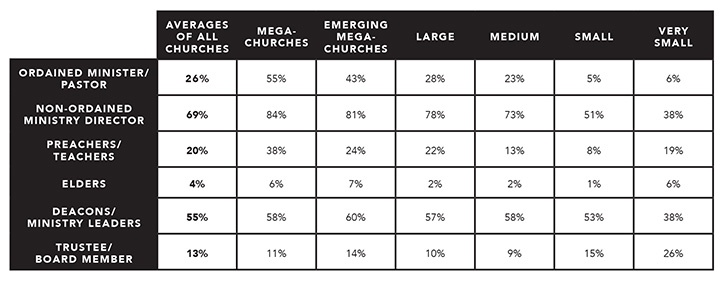By Kent E. Fillinger
The greatest and most important event in the history of the world—Jesus’ resurrection—was announced first to a small group of women who had loved and followed Jesus. These women then communicated the news to the rest of Jesus’ disciples.
In subsequent years, as the young church grew, women like Lydia, Phoebe, and Priscilla played notable roles.
Fast-forward to today. Where do we find women serving in the church? The short answer is—it depends on the church!
Our 2018 annual church survey sought to determine how women are serving in ministry leadership today.
Please note: My intent is not to promote any theological perspectives or provide any commentary on the biblical role of women in the church. Rather, I’m striving to share survey findings to help us understand the current reality.
In addition to the six ministry leadership roles included in the survey (which are listed in the chart), churches shared a number of “other” ministry roles women were fulfilling: Bible study teacher, small-group leader, sharing Communion and offering meditations, serving Communion and collecting the offering, reading Scripture in worship, serving as worship host and presenting announcements, leading and serving in outreach, leading in children and youth ministries, as worship leaders, performing weddings, day-care administration, leading in preschool or Christian school, women’s ministry leadership, serving on the senior leadership team, and counseling. Eight churches noted that they did not have women serving in any ministry leadership roles.
The accompanying chart identifies the six ministry leadership areas surveyed and includes a breakdown of the percentage of churches in each church size category engaging women in that type of ministry. The overall average is also included for each area of ministry.

Larger Church = More Opportunities
The survey showed that the larger the church, the greater likelihood of ministry leadership opportunities for women. For example, 55 percent of megachurches (average weekly worship attendance of 2,000 or more) had ordained women serving as ministers or pastors, compared with only 6 percent of very small churches (average weekly attendance of 99 or fewer). This was the greatest discernable ministry disparity between the largest and smallest churches we surveyed.
The second biggest disparity between megachurches and very small churches was for women serving as “non-ordained ministry directors”: 84 percent compared to 38 percent, respectively. This seems to indicate few very small churches have women on their ministry staffs (perhaps because many such churches have only one paid minister).
Interestingly, very small churches were far more likely than megachurches to have women serving as a “trustee or board member”: 26 percent compared to 11 percent, respectively.
Newer Church + Younger Lead Minister = More Opportunities
I sought to determine whether age of the church or the age of the lead minister had any impact on the number of ministry leadership opportunities available to women.
I discovered that newer churches had far greater opportunities for women to lead and serve. This was true for all areas of ministry leadership except those churches using women as trustees or board members.
The average age of churches using women in at least one area of ministry leadership was 66 years old. The average age of churches that do not use women in any leadership area was 78 years old.
The average age for churches using women to preach or teach was 59 years old. The churches not using women to preach or teach were, on average, 78 years old. The 19-year gap was the greatest of any ministry leadership category.
The survey found that churches with younger lead ministers provide more opportunities for women than churches with older lead ministers; this includes having women serving as ordained ministers or pastors, women preaching and teaching, and women serving as elders.
Among churches with women serving as elders, lead ministers were, on average, three years younger than lead ministers at churches without women elders. (Again, the only exception to this was for churches that had women serving as trustees or board members.)
The Big Two
Women preaching or teaching and women serving as elders have historically been lightning rod issues for our churches. It’s interesting how some positions have shifted over the last decade plus.
In 2008, we asked megachurches and emerging megachurches about women’s involvement in preaching or teaching. That year, 6 percent of megachurches and less than 1 percent of emerging megachurches (average weekly worship attendance of 1,000 to 1,999) reported having women preaching or teaching in worship services. That percentage increased significantly over a 10-year period. In 2018, 38 percent of megachurches and 24 percent of emerging megachurches reported that members of their preaching/teaching team included women. (Note that the way the question was asked in 2018 was actually more limiting than the way it was phrased 10 years earlier, and yet the numbers still increased significantly.)
In 2010, we asked churches ranging in size from medium churches (250 to 499 in average weekly attendance) to megachurches if they had women serving as elders. Overall, 3 percent of the churches surveyed in 2010 reported having women elders. Eight years later, that number inched up to 4 percent of churches.
Interestingly, in 2010, 9 percent of megachurches reported having women elders, but that number declined to 6 percent in 2018. Over this same period, however, emerging megachurches with women elders increased from 2 percent to 7 percent. Large (average attendance of 500 to 999) and medium churches were largely unchanged.
The Impact on Church Growth and Baptisms
Those churches where women had larger roles in leadership grew slightly faster than churches with fewer options for women (3.9 percent compared to 3.4 percent, respectively). The combined average growth rate for all churches in 2018 was 3.5 percent.
On the flip side, churches with fewer leadership opportunities for women had a slightly better baptism ratio (number of baptisms per 100 in average worship attendance) than churches with more options for women to lead (5.6 compared to 5.3, respectively). For the record, the overall average baptism ratio for all churches in 2018 was 5.6.
Where Do We Go from Here?
The trend in culture—and church, it seems—is to afford more opportunities to women, even in historically male-dominated fields. The week I wrote this article, Major League Baseball announced the hiring of its first female assistant coach. And we mustn’t overlook that more women than men graduate from college.
Will these cultural shifts continue to shape the church and its ministry leadership opportunities for women? Your guess is as good as mine! But I hope to continue to monitor the situation as future developments take place.
Kent E. Fillinger serves as president of 3:STRANDS Consulting, Indianapolis, Indiana, and regional vice president (Ohio, Pennsylvania, Michigan) with Christian Financial Resources.


0 Comments